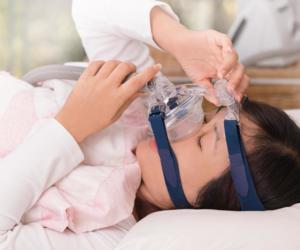New Device May Help Patients with Sleep Apnea

In today’s age, how often do people complain of trouble sleeping? Though many have this issue, few are aware that there is a whole range of sleeping disorders that they could have. In fact, so many sleeping disorders exist that a new branch of medicine was created, which is now known as sleep medicine. Sleep disorders have undergone much research in recent years, yielding new findings that may enable Obstructive Sleep Apnea (OSA) patients to once again obtain quality sleep.
What is OSA?
Obstructive Sleep Apnea is sleep disorder in which partial or complete obstruction of the upper airway occurs while sleeping. Breathing pauses can differ in duration, lasting a few seconds to a full minute, or in frequency, occurring 5 to 30 times in one hour. After these short pauses, breathing resumes as normal. Pauses in breathing occur due to the blockage of the airway during sleep, causing the chest muscles and diaphragm to work harder in order to open the airway. As a result, breathing is accompanied by a loud snoring sensation.
In medical education, pneumonic techniques, acronyms, and other techniques to help us better understand certain medical conditions are widely used. In regards to OSA, the signs and symptoms of the disorder are often referred to as the “3 S’s” — snoring, sleepiness, and a significant other who reports sleep apnea episodes. Recognizing these three common symptoms may assist a physician in correctly diagnosing the disorder.
To understand OSA, it is first important to understand sleep. During sleep, a cyclic alternation between non-rapid eye movement (NREM) and rapid eye movement (REM) occurs. In the NREM phase, the body’s parasympathetic nervous system (PSNS) predominates, causing lower blood pressure, a slowed heart rate, muscle relaxation. Before awakening, the REM phases occurs, which is controlled by the sympathetic nervous system (SNS), causing higher blood pressure, a higher heart rate, and muscles contractions.
Anatomically, our throat is made of both hard walls and soft tissues which might collapse during sleep as a result of PSNS domination, leading to OSA.
People suffering from OSA are usually unaware of their problem; constant snoring usually bothers their family members and others who share the same bedroom. In fact, tortured by snoring and gasping during night, loved ones of those suffering from OSA are often jealous of their partners/family members because they appear to be such sound sleepers. However, few were able to recognize daytime sleep as a serious sign of nocturnal episodes of apnea.
Is This Common?
Yes, OSA is a common phenomenon. OSA may initially occur as a result of an infection of the upper respiratory tract. Those with colds or viral infections such a mononucleosis may have difficulty breathing during sleep due to inflammation in the sinuses and tonsils, which may then lead to the development of OSA. In addition, some substances, like alcohol,may lead to muscle relaxation and episodes of apnea.
Yet, more than 18 million Americans suffer from chronic OSA. Although OSA seems like a minor health issue and in most cases goes undiagnosed, OSA can lead to serious conditions and diseases.
Epidemiological surveys show an increased number of people with OSA. This condition affects both children and adults, although it is more prevalent in adults. The risk of OSA increases with age. Therefore, OSA is more common among elderly persons over 65 years of age.
OSA seems to be more common in males. However, women with increased level of male sex hormones (called androgens) are at a higher risk of developing OSA. Lower levels of female sex hormones and elevated androgen hormones are usual during menopause, which may put menopausal women at risk for the development of OSA.
The Causes of OSA
There are a great number of factors that can cause OSA. First, as previously mentioned, older age is very important risk factor. This can be explained by the general muscular and neurological decrease of muscle tone with age, including the muscles of the airway. As previously mentioned, sex is also important risk factor, with men being more frequently affected by OSA. However, women with decreased levels of female sex hormones due to menopause or earlier in life due to hormonal imbalanceare at an increased risk.
Obesity is another risk factor, especially in cases of central fat distribution in which fat accumulate in the abdomen, torso, and neck.
Substance use can also decrease muscle tone and lead to episodes of OSA: most often in cases of depressants, sedatives, or alcohol use.
Some other conditions, such as stroke or neurological syndromes like muscular dystrophy may also contributes to OSA. Down syndrome, a chromosomal abnormality that results in certain structural deviations, including a narrow throat and a large tongue, can also contribute to OSA.
OSA might also be associated with structural factors, such as anatomic deviations of head and neck, enlarged tonsils, nasal septum deviation, polyps in the throat, and more.
This condition might also develop as part of a postoperative complication during pharyngeal surgery.
There is a lot of evidence regarding the association of OSA with serious medical conditions. People with OSA are at higher risk of high blood pressure, heart diseases, type 2 diabetes, and mental health issues, such as depression or anxiety.
During the day, due to a lack of true sleep at night, it is usual for people with OSA to feel constantly tired, even though they seem to have slept for a generous amount of time. Lack of oxygen to brain during sleep can lead to problems with concentration and memory. After waking up, a headache or a dry throat are common manifestations of OSA. Mood changes may result in depression or anxiety. In persons with severe OSA, sexual dysfunction might also occur.
Constant urges to rest or sleep during the day might be potentially dangerous and result in motor vehicle accidents or occupational hazards.
Treatment
There are several treatment options for OSA, depending on the underlying cause. If obesity is the main cause, weight loss will be recommended. If alcohol consumption is the primary cause, cessation of alcohol consumption may be necessary in order to treat the disorder. Some patients might be advised to add extra pillows beneath their heads at bedtime in order to elevate the head and torso. Sufferers of OSA might also be advised to sleep in a sidling position rather than on the back.
In case of certain conditions such as enlarged tonsils, deviation of the nasal septum, or polyps in the throat, surgery might resolve OSA.
Standard procedure in OSA treatment is the use of CPAP, or a continuous positive airway pressure device. A CPAP device consists of a mask that covers the nose and mouth to provide positive pressure during sleep that will prevent airway collapse. This means that patients will wear a mask over the nose and/or mouth every night in order to prevent the occurrence of OSA.
Even though the use of CPAP seems like a better solution, in comparison to surgical or medical management, OSA patients may find CPAP to be annoying or uncomfortable.
Inspire
Recently, there has been a breakthrough in OSA treatment. A new neurostimulating device called Inspire was recently introduced and warmly embraced by patients suffering from severe OSA. This device delivers electrical impulses to the hypoglossal nerve, which is the nerve that is responsible for controlling the muscles of the tongue. Stimulating the hypoglossal nerve prevents the tongue from collapsing during sleep and obstructing the upper airway. To use Inspire, patients simply switch it on before sleep and switch off after wakening, so they have full control over the implanted neurostimulator.
So far this device is available only at specialized sleep centers, but in years to come, this treatment may replace the use of the CPAP.















